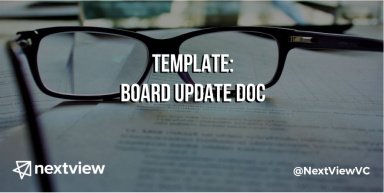
Publication number: ELQ-22201-1
View all versions & Certificate

How to Create a Board Update Document (Seed-Stage-Friendly)
This is an alternative to board decks that is sometimes preferred by VCs. This works well for seed-stage startups.
Introduction
Based on feedback from our portfolio and the broader startup community, NextView has created pre-formatted board deck templates for seed-stage startups. Included in that deck was something that caught some folks by surprise.
While there was indeed a PowerPoint template to use, we also built out a proposed Google Doc or Word Doc to use as a direct substitute for actual slides.
As I’ve written in the past, board decks and board meetings can waste loads of time at the seed stage. These startups are still super raw, lacking the piles of data and charts going up and to the right (or really in any direction) that are conducive to the stereotypical board deck.
So, rather than try and fill time unnecessarily and create a lengthy deck just because you’re “supposed to,” many investors will often suggest that a founder create a simple one-sheeter that might start small and build over time. Perhaps this turns into a bigger deck down the road, or perhaps it remains a running log where all important meeting updates are saved.
Regardless, this document is a viable alternative to creating decks at the seed stage, and we wanted to deconstruct what that might look like below. (Obviously, this is NextView’s opinion. You should still work with your board about what format they prefer.)
Here’s an exact, step-by-step breakdown of how we’d recommend structuring it. This is pulled from NextView’s board deck resource, which was compiled using a combination of real startup board decks and input from my partners and me.
- Step n°1 |
Header & Section 1
Header
Place the most recent meeting notes at the top of the doc with the date of your meeting. Over time, as more board meetings pass, this removes the need to scroll all the way down just to see today’s update.
Section 1: “High Level Summary”
This is a short section that we’d recommend structuring in one of two ways.
Option 1: In a few sentences, summarize some of the major progress made and/or challenges uncovered. Include both positives and negatives for a more productive board conversation, which is especially critical in the seed stage since nearly everything is in “figure it out” mode. You should also include three to five bullets that list critical updates or data points.
Option 2: Divide the section into two smaller sections — “Highlights/Big Wins” and “Challenges/Setbacks.” Below each, list the must-know details such that your board can read and understand ahead of the actual meeting. The Challenges/Setbacks section should be completely transparent to set up a candid, productive discussion. Good seed-stage investors understand that the first 18-24 months of your company’s evolution will be very raw and rocky. They should be ready and able to guide you through some of those challenges. - Step n°2 |
Section 2: Housekeeping
Bullet out a few of your housekeeping items. In most cases, this section will be “read only” in that it may not be discussed in person. However, these are important updates for your board to know.
Examples of housekeeping include the following list, though not every item will appear every time:
Finance: Cash out date, burn rate, 409A valuation, cap table, common/preferred stock dashboard.
Team: Hires, fires, departures, responsibility changes, major promotions, and your org chart. The latter is especially important for that first meeting to give your board a sense for the current team struture and personnel.
Office and Logistics: Potential moves and cost (rent plus dollars per square foot plus lease length), insurance, healthcare, legal, and other services.
Previous Meeting Recap: High-level overview of last meeting, with action items, owners, and completion status.
Note that “housekeeping” doesn’t mean “not important.” Finance is mission critical, for instance – it just appears on a recurring basis. Hiring is also essential and may appear regularly, though it will fluctuate in volume and urgency.

